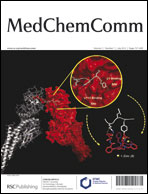A homodimeric bivalent radioligand derived from 1-(2-methoxyphenyl)piperazine with high affinity for in vivo 5-HT1A receptor imaging†
Abstract
The bivalent ligand approach is very promising and can give rise to molecular probes with enhanced conformational flexibility for tissue selective modulation. In this study we describe the synthesis of a homodimeric 5-HT1A receptor ligand by incorporating two identical pharmacophores , 1-(2-methoxyphenyl)piperazine, linked through DTPA. This bivalent derivative was efficiently synthesized and characterized by 1H, 13C NMR and mass spectroscopy. 99mTc-labeling was performed with a high radiolabeling yield (>95%) and radiochemical purity (>98%) using very low ligand concentration. In vitro studies were carried out on hippocampal cultures and PC3 cell lines which express 5-HT1A receptors. The selectivity of the complex for 5-HT1A receptors is 1000 times more than it is for 5-HT2A receptors, with Kd in picomolar range. Hill coefficients between 1.9 and 2.3 were observed, indicating that the homodimeric binding pharmacophores appear to be essential for the cooperative binding mode. In vitro binding assays in rat hippocampal cultures demonstrated the high affinity of the complex for 5-HT1A receptors. Further studies include in vivo organ distribution and gamma scintigraphy carried out in rat and rabbit. Plasma clearance rate (CR) revealed a value of 4.86 μg mL−1 min−1 in normal rabbit. Dynamic imaging performed in rabbit showed the beginning of radiolabeled uptake in brain as early as 2 min. The tumor-to-contralateral muscle tissue ratio of 99mTc–DTPA–bis(MPBA) in athymic mice with PC3 xenograft was found to be 65 ± 3.3 at 1 h. Significant accumulation was seen in mice and rat brain at 10 min with 2.07 ± 0.76% ID g−1 and 2.81% ID g−1 respectively. The high uptake in hippocampus and cerebral cortex was accredited to the 5-HT1A receptor rich regions in post mortem rat brain. This imaging agent holds a promising future in imaging 5-HT1A receptors for the effective diagnosis of neuropathological disorders.


 Please wait while we load your content...
Please wait while we load your content...